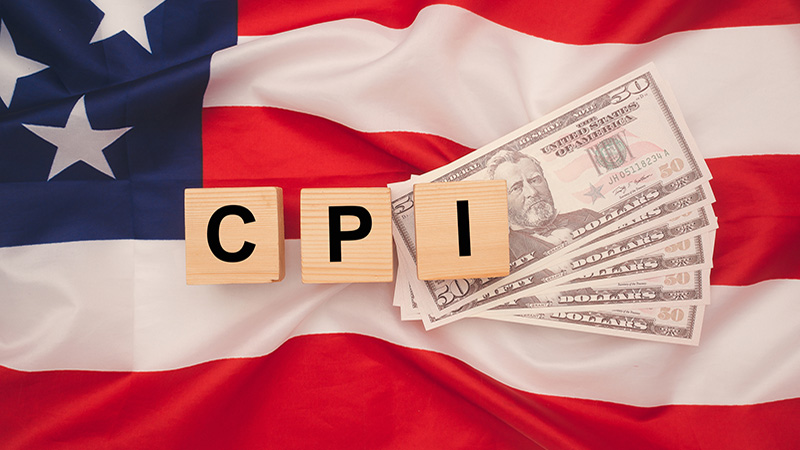May CPI Miss, 75% Odds of Fed Rate Cut Before Sep.
U.S. consumer inflation in May came in lower than expected, suggesting that businesses have largely absorbed the costs of new tariffs rather than passing them on to consumers.Specifically, headline CP

U.S. consumer inflation in May came in lower than expected, suggesting that businesses have largely absorbed the costs of new tariffs rather than passing them on to consumers.
Specifically, headline CPI rose 0.1% month-on-month, below the 0.2% consensus, and increased 2.4% year-on-year, matching expectations.

Core CPI—which excludes the more volatile food and energy categories—rose 0.1% month-on-month, also below the 0.2% forecast, and increased 2.8% year-on-year, missing the expected 2.9%.

Following the data release, U.S. equity futures and gold prices rose briefly, but equities later declined after the market opened, and gold gave back most of its gains. The interest rate swap market now shows a 75% probability of a Fed rate cut before September.
Looking deeper into the data, the biggest contributor to the slowdown in CPI was lower energy prices, with gasoline down 2.6%. Prices for both new and used vehicles fell, and apparel prices also declined.
However, categories more exposed to U.S.-China tariffs showed significant price increases. Toy prices posted their largest rise since 2023, and large home appliances saw their biggest price surge in nearly five years—both being strong export categories for China. Grocery prices rose 0.3% after falling in April. Prices for grains, fish, and bacon rose, while egg prices fell nearly 3%. A historically low U.S. cattle inventory pushed ground beef prices higher.
In the services sector—one of the main inflation drivers in recent years—housing costs rose 0.3% for the second consecutive month, remaining the largest contributor to month-on-month CPI growth.
With mortgage rates near 7% and home prices at record highs, affordability has plummeted. First-time homebuyers now account for only 24% of home purchases, down from 50% in 2010.

As more people are priced out of buying homes, they turn to renting—putting upward pressure on rents and contributing to housing inflation.

Excluding housing and energy, service prices rose 0.1% month-on-month and 2.9% year-on-year. Within that, travel-related services like airfares and hotel stays fell, as did entertainment like sports event tickets, indicating a pullback in discretionary spending. However, prices rose in healthcare, motor vehicle insurance, home decor and operations, personal care, and education.
Retailers Warn of Future Price Increases
Looking ahead, major retailers such as Walmart Inc. and Target Corp. have warned of potential price hikes, echoed by automakers like Ford Motor Co. and Subaru Corp.
A recent Fed survey of economic activity showed that prices have risen at a “moderate” pace across the U.S. in recent weeks, with some regions expecting future price increases to be “strong, significant, or substantial.” Much will depend on the direction of U.S. trade policy.

What Do Economists Say?
Bloomberg economists Anna Wong and Stuart Paul noted:
“It’s not that firms haven’t passed on tariffs—they have, as shown by strong pass-through in tariff-exposed categories. But deflation in recreational services and durable goods like autos—classic signs of cautious consumer behavior and income insecurity—more than offset those increases.”
Fitch Ratings Chief Economist Brian Coulton added:
“Inventory buildup ahead of tariff hikes may be delaying pass-through. Uncertainty around U.S. trade policy also likely slowed firms’ price adjustments. Still, a rise in core goods inflation in the coming months remains highly likely. Today’s softer inflation is reassuring, but only to a point. Tariff-driven inflation may not appear in CPI data for several months.
It’s too early to assume we’ve dodged the price shock. Like other macro data, there’s limited clarity in current figures. We’ll likely need to wait until late summer to fully see tariff impacts—whether in margins or inflation data.”
Goldman Sachs Global Co-CIO Alexandra Wilson-Elizondo said:
“May inflation was lower than expected, suggesting tariffs aren’t yet having a large immediate effect because firms are using inventory or cautiously adjusting prices due to uncertain demand. While goods prices may rise later, services are expected to remain steady, so any inflation pickup is likely temporary.”
Disclaimer: The views in this article are from the original Creator and do not represent the views or position of Hawk Insight. The content of the article is for reference, communication and learning only, and does not constitute investment advice. If it involves copyright issues, please contact us for deletion.